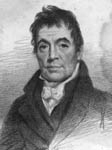John Philpott Curran
John Philpott Curran, the great Irish barrister and orator, was born on the 24th of July 1750 in Main Street, Newmarket. His father James was a local judge for minor affairs for the Manor area of Newmarket.
Curran went to the local Protestant school, where his intellectual ability was spotted by the parson, Rev. Nathaniel Boyse, who arranged to have Curran educated at Midleton, County Cork. He studied law at Trinity College, Dublin (he was described as “the wildest, wittiest, dreamiest student”) and continued his legal studies in London at King’s Inns and the Middle Temple. He was called to the Irish bar in 1775.
His occasional tendency of challenging people to duels (he fought five in all) rather than compromise his values, along with his skilful oratory, quick wit and his championing of popular Irish causes such as Catholic Emancipation, made him one of the most popular lawyers in Ireland. He also could speak Irish, still the language of the majority at that time. He wrote a large amount of humorous and romantic poetry. Including The Deserter’s Meditation below (which is also known as Let Us Be Merry Before We Go). This poem is considered to be the first poem in English that used the vowel format characteristic of Irish Language poetry. It is closely based on the popular drinking song Preab san Ól and is sung to the air of that song.:
” If sadly thinking, with spirits sinking,
Could more than drinking my cares compose,
A cure for sorrow my sighs would borrow
And hope tomorrow would end my woes.
But as in wailing there’s naught availing
And Death unfailing will strike the blow
And for that reason, and for a season,
Let us be merry before we go.
To joy a stranger, a wayworn ranger,
In every danger my course of I’ve run
Now hope all ending, and death befriending,
His last aid lending, my cares are done.
No more a rover, or hapless lover,
My griefs are over — my glass runs low;
Then for that reason, and for a season,
Let us be merry before we go.”
In 1774 he married Sarah Creagh of Newmarket. Among his children were Sarah, the beloved of Robert Emmet; Amelia, an artist whose painting of Percy Byrshe Shelley hangs in the National Art Gallery in London; and Gertrude, a child musical prodigy who at 12 years of age tumbled to her death from an upstairs window in their house in the Priory, Rathfarnham. Curran was so attached to his little daughter that he, controversially, had her buried in the grounds so that he could observe her grave from his study window. (Picture below shows the door knocker from priory house)
One of Curran’s more notable cases was that of Father Neale and Lord Doneraile in 1780. Father Neale, an elderly Catholic priest in County Cork, criticised an adulterous parishioner, whose sister was mistress to Lord Doneraile, a Protestant landlord. Doneraile demanded that Neale recant his criticism of his mistress’ brother. When the priest stood by his principles, Doneraile horse-whipped him, confident that a jury would not convict a Protestant on charges brought forward by a Catholic. Curran who had a fearless and passionate belief in justice represented the priest and won over the jury by setting aside the issue of religion. The jury awarded Curran’s client 30 guineas. Doneraile challenged Curran to a duel, in which Doneraile fired and missed. Curran declined to fire.
In 1798, he defended the leaders of the United Irishmen, the most notable being Wolfe Tone, Napper Tandy and the Sheares Brothers. He stood firm in the face of a government campaign of intimidation and terror and continued to defend the United men despite bought and biased judges, packed juries and government agents called as false witnesses. He was a real threat in the eyes of the authorities. His support for the united Irishmen was, however tempered by the bloodshed and social mayhem he saw during visits to France during the Revolution and he became convinced that violence was not the way to right Ireland’s wrongs. When Emmet’s rising took place it provided the government with the opportunity to finally silence Curran. Letters between Emmet and Curran’s daughter had been intercepted and a raid on his house while he was absent finally forced hm to capitulate and accept a minor government appointment. He refused to defend Emmet and sent Sarah to Quaker friends of his in Cork where he felt she would be safe.
Started in 1780, his drinking club The Order of St. Patrick also included Catholic members along with liberal lawyers (who then had to be Protestant). They were called The Monks of the Screw, as they appreciated wine and corkscrews. Curran was its Prior and consequently named his Rathfarnham home “The Priory”.
On the 14th of October 1817, he collapsed and died a broken man, and was buried in London. In 1834 his body was exhumed and reintered in Glasnevin Cemetery in Dublin.




